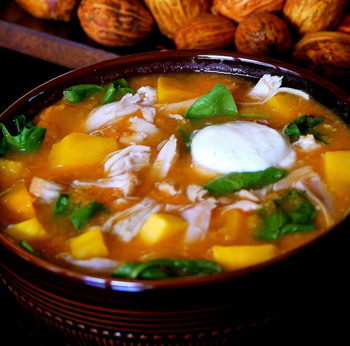 I can't make pancakes. Nope. Just can't. Other than my fleeting victory with Nigella's ricotta hotcakes last August (which technically aren't pancakes), I haven't had much pancake success.
I can't make pancakes. Nope. Just can't. Other than my fleeting victory with Nigella's ricotta hotcakes last August (which technically aren't pancakes), I haven't had much pancake success.
I've tried recipes from Gourmet, Bon Appetit, Cooking Light, and even Martha. They always come too heavy or too dry or too flat.
So when Jeff and I felt like having pancakes on Sunday, I went where no respectful food writer goes – to the Bisquick section of the supermarket baking aisle.
There I furtively placed a box of Heart Smart Bisquick in my cart, proceeded to the checkout, and almost made it to my car, when I was accosted by the Food Blogging paparazzi. Despite my protestations, their persistence was formidable.

 Parsnips. Parsnips parsnips parsnips.
Parsnips. Parsnips parsnips parsnips. Stuffing, mashed potatoes, sweet potato casserole, green bean casserole. Most people will say that Thanksgiving isn't a holiday without these traditional dishes, but that doesn't have to be the case. Although they are classics, it doesn't mean they can't be reinterpreted, reimagined, or replaced with an equally interesting seasonal side dish. When vegetarians are around, it's also courteous to keep them in mind when planning the menu.
Stuffing, mashed potatoes, sweet potato casserole, green bean casserole. Most people will say that Thanksgiving isn't a holiday without these traditional dishes, but that doesn't have to be the case. Although they are classics, it doesn't mean they can't be reinterpreted, reimagined, or replaced with an equally interesting seasonal side dish. When vegetarians are around, it's also courteous to keep them in mind when planning the menu. It can be a challenge cooking for two. When I made a big batch of
It can be a challenge cooking for two. When I made a big batch of  When the pole bean trellis blew down for the second time, we left it. Granted, we were a bit annoyed at the pole beans. They took a lifetime to germinate and what seemed like eternity to start yielding. Meanwhile the bush beans were churning out lovely filet beans by the pound every day. We would have ignored the pole beans altogether except for this nagging voice I had in my head, “Pole beans are better than bush beans.” I grew up with this voice. My father’s.
When the pole bean trellis blew down for the second time, we left it. Granted, we were a bit annoyed at the pole beans. They took a lifetime to germinate and what seemed like eternity to start yielding. Meanwhile the bush beans were churning out lovely filet beans by the pound every day. We would have ignored the pole beans altogether except for this nagging voice I had in my head, “Pole beans are better than bush beans.” I grew up with this voice. My father’s.